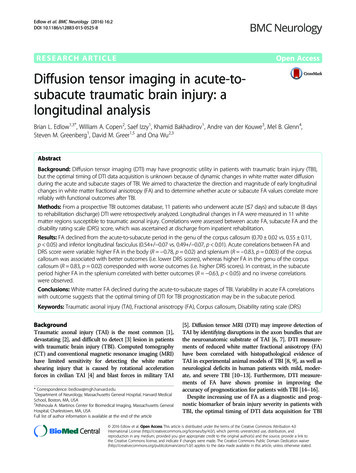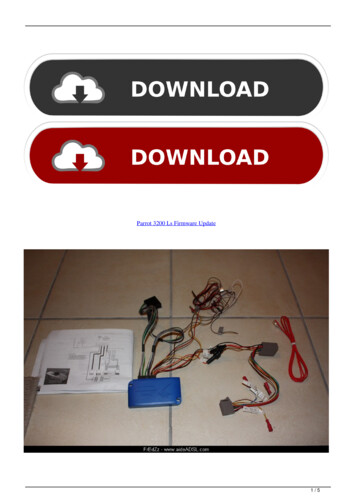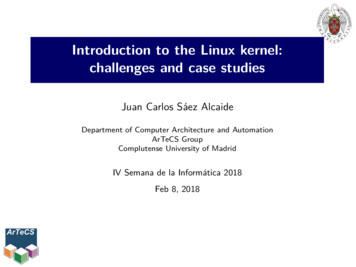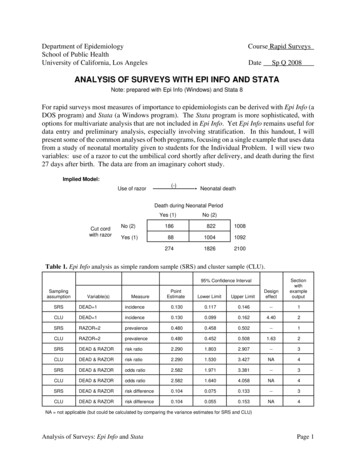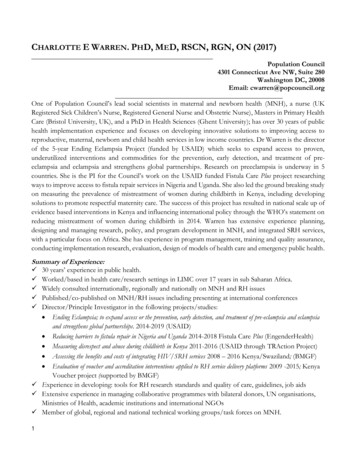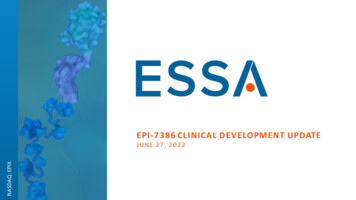
Transcription
EPI-7386 CLINICAL D EV ELO PMENT UPDATENASDAQ: EPIXJU N E 2 7 , 2 0 2 2
Forward Looking StatementsCertain written statements in and/or oral statements made in connection with this presentation may be considered forward-looking statements within the meaning ofapplicable Canadian securities laws and the United States securities laws, that may not be based on historical fact, including, without limitation, statements containingthe words “believe”, “may”, “plan”, “will”, “estimate”, “continue”, “anticipate”, “predict”, “project”, “intend”, “expect”, “potential” and similar expressions. Forwardlooking statements in this presentation include, but are not limited to: ESSA’s upcoming milestones; Window-of-Opportunity and combination studies leading tobiological and clinical insights; the possibility of greater AR suppression from EPI-7386’s combination with antiandrogen therapies; the effectiveness of existing ARdirected therapies; potential treatments for EPI-7386; the design and success of EPI-7386’s Phase 1a/1b monotherapy study and questions addressed thereby; plannedstudies under the EPI-7386 Combination Development Program; EPI-7386’s drug-drug interactions and safety in combination with other therapies; the identification ofAR-driven tumors for effective EPI-7386 monotherapy; dose expansion and identification of new and optimal patient populations; and potential market opportunitiesfor EPI-73896.Forward-looking statements and information are subject to various known and unknown risks and uncertainties, many of which are beyond the ability of ESSA tocontrol or predict, and which may cause ESSA’s actual results, performance or achievements to be materially different from those expressed or implied thereby. Suchstatements reflect ESSA’s current views with respect to future events, are subject to risks and uncertainties and are necessarily based upon a number of estimates andassumptions that, while considered reasonable by ESSA as of the date of such statements, are inherently subject to significant medical, scientific, business, economic,competitive, political and social uncertainties and contingencies, many of which, with respect to future events, are subject to change. In making forward-lookingstatements, ESSA may make various material assumptions, including but not limited to the market and demand for the securities of ESSA, general business, marketand economic conditions, partner participation in combination clinical trials, obtaining positive results of clinical trials, and obtaining regulatory approvals.Forward-looking information is developed based on assumptions about such risks, uncertainties and other factors set out herein and in ESSA’s Annual Report on Form10-K filed on November 18, 2021 under the heading “Risk Factors”, a copy of which is available on ESSA’s profile on the SEDAR website at www.sedar.com, ESSA’sprofile on EDGAR at www.sec.gov, and as otherwise disclosed from time to time on ESSA’s SEDAR profile and EDGAR profile. Forward-looking statements are madebased on management's beliefs, estimates and opinions on the date that statements are made and ESSA undertakes no obligation to update forward-lookingstatements if these beliefs, estimates and opinions or other circumstances should change, except as may be required by applicable Canadian and United Statessecurities laws. Investors are cautioned that forward-looking statements are not guarantees of future performance and investors are cautioned not to put unduereliance on forward-looking statements due to their inherent uncertainty.2
EPI-7386 Demonstrates a Clean Safety Profile and Anti-tumorActivity in Heavily Pretreated PatientsThe drug exhibits favorable ADME properties with target drug plasma exposures achieved;BID dosing allows higher trough drug levelsEPI-7386 is safe and well-tolerated at all doses, schedules and combinations testedEPI-7386The Phase 1a mCRPC monotherapy study reveals the biological complexity and heterogeneityof late-stage mCRPC patientsDespite this biological complexity, EPI-7386 shows clear signals of AR-biology inhibition and clinical effectsThe upcoming Phase 1b study is expected to further narrow enrollment criteria and deeplycharacterize patient biology with the goal of identifying the most appropriate patientsThe first combination cohort of EPI-7386 plus enzalutamide (Xtandi ) was safe andwell-tolerated with drug exposures in the biologically active ranges3
EPI-7386 is Uniquely Designed to Prevent AR Transcription by Bindingto the NTD All current antiandrogens function through the ligandbinding domain (LBD) of the androgen receptor (AR) Known antiandrogen resistance mechanismsdevelop at the LBD EPI-7386 specifically binds to the N-terminal domain(NTD) of the AR, a region of the androgen receptorrequired for AR activity As a result of this binding, EPI-7386 is active againstmultiple AR forms, including those resistant to currentantiandrogens EPI-7386’s novel method of inhibiting the AR may leadto greater AR suppression when used in combinationwith current antiandrogen therapiesN-terminal domainDNA-binding domainLigand-binding domainGranted unique USAN drug stem of “Aniten” as a AR NTD inhibitor1. Hong NH, et al. AACR-NCI-EORTC-Virtual Int Conf, 2021.2. De Mol E, et al. ACS Chem Biol, 2016.3. Andersen RJ, et al. Cancer Cell, 2010.4. De Mol E, et al. ACS Chem Biol, 2016.5. Yang YC, et al. Clin Cancer Res, 2016.4
EPI-7386 Drug tencyIn vitro potency in the range of second-generation antiandrogensActivityIn vivo xenograft anti-tumor activity in both antiandrogen-sensitive & resistant modelsADME/PKSafetyLow in vitro metabolism, good animal ADME & human t1/2 24 hrsSpecific NTD on-target activity, minimal off-target binding, clean toxicology profileDDIAppropriate properties to combine with other drugs (e.g. drug-drug interactions (DDI), etc.)CMCSimple synthesis of drug substance and favorable pharmaceutical properties for the drug product5
The Evolution of Prostate Cancer AR Dependency Under nicallyLocalizedDiseaseRising PSANoncastratemCSPCmCRPCmCRPCmCRPC1st Line2nd Line3rd LinenmCRPCAR Genomic Structural Rearrangements and Splice VariantsAR AmplificationAR LBD Point MutationsAR DependentAR IndependentPTEN-PI3K-AKT, Wnt, neuroendocrine, other tumor growth driversEPI-7386Development1. Adopted from Scher HI, et al. J Clin Oncol, 2016.Current EPI-7386Monotherapy6
EPI-7386 Monotherapy
The EPI-7386 Phase 1a/1b Monotherapy Study (First-in-Human) isDesigned to Answer Four Major Questions Are safety and tolerability of EPI7386 acceptable for use in postsecond-generation mCRPC patientpopulation?Safety andTolerability Can we define patient populationswhere EPI-7386 may be more/lessactive?Optimal PatientPopulation Can we define the role of intra-patienttumor heterogeneity on drug ivity Do drug exposures exceed thepredicted efficacious thresholdsobserved in a preclinicalenzalutamide-resistant model? Is there clinical evidence ofandrogen-pathway inhibition? Is there evidence of clinicallyimportant efficacy signals ?Recommended Expansion Phase Dose(s)8
EPI-7386 Phase 1a/1b Monotherapy Study in mCRPC Patients:Study Design First-in-human Phase 1 multi-center open-label study enrolling mCRPC patients failing standard-of-care therapy Two-part study: Phase 1a dose-escalation followed by Phase 1b dose expansionPhase 1a: QD Dosing RegimenOriginal ProtocolN 31 patientsQD dosing1000 mgPhase 1a: BID Dosing RegimenAmended ProtocolN up to 12 patientsBID dosingDLT periodongoing800 mg600 mg BID600 mg(1200 mg/day)400 mg200 mg No limitations on the # prior lines of therapy Visceral metastases permitted Prior chemotherapy permitted400 mg BID1200 mg(800 mg/day)) Limited to 3 prior lines of therapy Exclusion of visceral metastases One line of prior chemotherapy permitted9
Patients Enrolled in the Phase 1a Under the QD Dosing Regimenwere Heavily PretreatedParameterQDn 31Median age (range), yrs72 (50-85) yrsECOG performance status, n (%) 0 1 7 (22.6%) 24 (77.4%)Median no. lines of prior therapy (range)7 (4-13)Median no. lines of prior therapy for mCRPC(range)4 (2-10) Median # prior therapies 7 Median # prior therapies formCRPC 4 Patients treated with both ABIand Lutamides 83% Patients treated with priorchemotherapy 58.1%Type of prior therapy, n (%) Abiraterone (“ABI”)Enzalutamide (“ENZ”)Both (ABI ENZ)Darolutamide/ApalutamideChemotherapyData as of June 1, 2022 27 (87.1%)25 (80.6%)22 (71%)4 (12.9%)18 (58.1%)Existing AR-directed therapiesexpected to be ineffective10
Clinically, the Patients Enrolled Under the QD Dosing Regimenhad Rapidly Progressive Disease and High Tumor BurdenParameterQDn 31Median baseline PSA, (range), ng/ml94.5 (5.4-1900)Median baseline PSA doubling time (range),months2.1 (0.85 -9.5)Median baseline ctDNA* % (range)High tumor burden documented by: High baseline levels of PSA and% of ctDNA Presence of visceral disease andmarkers of neuro-endocrinedifferentiation in 1/3 ofpatients29% (4-73%)Visceral Disease, n (%)9 (29%)NSE** 10 ng/ml, n (%)9 (29%)*Circulating tumor DNA (“ctDNA”)**Neuron-specific enolase (“NSE”)Rapidly progressive diseasedocumented by short medianbaseline PSA doubling time ( 2months)11
Molecularly, Patients Enrolled Under the QD Dosing Regimen hada High % of non-AR Molecular Alterations at BaselineMolecular AlterationSubtypeAR-associatedFrequency(n 29)86% AR amplification AR structural variants AR mutationsNon-AR-associated48%38%31%93% PI3K pathwayDNA repairTP53Rb1WNT pathway55%55%48%38%24%High % of non-AR molecular alterations is characteristic ofadvanced mCRPC patients unlikelyto respond to AR-targeted therapies12
Patients Enrolled Under the BID Dosing Regimen have Less Advanced Diseasethan Patients Enrolled under the QD Dosing Regimen Per Study DesignParameterMedian age (range), yrsBIDn 570 (53-77)ECOG performance status, n (%) 0 1Median no. lines of prior therapy for mCRPC(range) 3 (60.0%) 2 (40.0%)2 (2-3)ABIENZBoth (ABI ENZ)Chemotherapyn 5Median Baseline PSA levels, (range), ng/ml14 (4.4- 580)Median baseline PSA doubling time (range),months3.4 (1.0- 14.3)NSE 10 ng/ml, n (%)0 (0)Molecular characterizationn 4Median baseline ctDNA % (range)7.5 (0-65)AR-associated alterations (n 3) AR gain/amplification AR mutations AR structural alterationsType of prior therapy, n (%) Parameter 3 (60.0)2 (40.0)2 (40.0)2 (40.0)66%33%33%Non-AR-associated alterations (n 3) PI3K pathwayDNA repairWNT pathwayTP53Rb133%33%33%66%33%13
EPI-7386 is Well-Tolerated at All Dose Levels and Schedules (QDand BID regimens) Administered in the Phase 1a (n 36)Grade 1n (%)Grade 2n (%)Grade 3**n (%)Totaln (%)Anemia9 (25)2 (5.6)1 (2.8)12 (33.3)Diarrhea5 (13.9)5 (13.9)0 (0)10 (27.8)0 (0)1 (2.8)0 (0)1 (2.8)Nausea6 (16.7)1 (2.8)0 (0)7 (19.4)Fatigue1 (2.8)5 (13.9)0 (0)6 (16.7)0 (0)5 (13.9)0 (0)5 (13.9)TRAE* TermDyspepsiaHot Flush All TRAEs (exception of oneoccurrence of Grade 3anemia the attribution ofwhich was ultimately changedby PI to “unlikely related”)were Grade 1 and 2 No apparent dosedependency was observed All the Grade 2 TRAEs ofdiarrhea occurred at doses 600 mg QD Low dose-reduction rate(8.1%) due to related AEs (3cases of Grade 2 diarrhea)*Treatment Related Adverse Event (“TRAE”)**Initially, principal investigator considered Grade 3 anemia in a patient who received 400 mg BID EPI-7386 as “possibly related” (due to antiandrogen safety profile) although confounded by concurrent rapid bone disease progression (ALP 1,000); laterchanged to “unlikely related”14
SAEs were Uncommon and Attributed to Disease Progression orUnderlying Co-morbiditiesSAE* TermSubject n (%)Acute kidney injury1 (2.8)Anemia**1 (2.8)Back pain1 (2.8)Disease progression1 (2.8)Diverticulitis1 (2.8)General physical health deterioration1 (2.8)Malignant pleural effusion2 (2.8)Pathological fracture0 (0)Pulmonary embolism2 (5.6)Pulmonary oedema1 (2.8)Pyrexia1 (2.8)Spinal cord compression1 (2.8)Data as of June 1, 2022*Serious Adverse Event (“SAE”)**Initially, principal investigator considered Grade 3 anemia in a patient who received 400 mg BID EPI-7386 as “possibly related” (due to antiandrogen safety profile) although confounded by concurrent rapid bone disease progression (ALP 1,000); laterchanged to “unlikely related”15
EPI-7386 Exposures Reached the Predicted Efficacious ThresholdsObserved in Preclinical Enzalutamide-Resistant ModelsIDDgm400mgBQDQmg1000Q400mgQgm200DBID dosing allows for higher Cmin druglevelsQ 0gThe 600 mg QD cohort exhibited thehighest AUC200,000D Predictedefficaciousexposurerange basedon preclinicalmodels800Doses 400mg per day of EPI-7386exhibit AUC concentrations generallyabove the highest target drug threshold400,000m All doses reached exposures above theminimum target drug threshold600,000D The steady state AUC EPI-7386 exposureincreases with higher doses800,000600 EPI-7386 C1D28 AUC Across DosesEPI-7386 has a long half life ( 24hrs)which supports QD administrationAUC0-24 (hr*ng/mL) 16
Longer Duration of Treatment is Associated with Less Prior Therapyfor mCRPCQD Dosing Regimen Patients 30% of patients across all dose levels remainedon therapy longer than 3 months The patients who progressed before or at 12weeks had in general: 10 ng/mL NSE, priorchemotherapy, visceral metastases and received 3 lines of therapy for mCRPC One patients was treated for 18 months; onepatient is currently on study at 1000 mg QD incycle 13 No obvious dose response observedBID Dosing Regimen Patients Short follow up but 3 of 5 patients ongoing with2 patients on therapy longer than 3 months*NSE level association with neuro-endocrine differentiation - IJBM 201817
Several Parameters were Used to Assess the AntiandrogenEffects of EPI-7386 in this Advanced mCRPC Patient PopulationMetabolic effects as measured by:Anti-tumor effects as measured by: Changes in serum cholesterol levels Changes in circulating PSA levels Changes in ctDNA levels (Wyatt - CRPC2020 panel –73 genes) 1-3 Radiographic changes in disease burden measured byboth traditional RECIST criteria as well as by totallesions volumetric quantification using the AIQSolutions platformNote: CTC counts and AR-V7 expression in CTCs were also measured but theassays used did not provide reproducible interpretable results for technicalreasons1Annala M, et al. Cancer Discov, 2018.et al. Eur Urol, 2019.Warner E, et al. Clin Cancer Res, 2021.2 Vandekerkhove G,318
Antiandrogen Effects of EPI-7386 on Cholesterol 1Therefore, lipid increases during EPI7386 administration can act as asurrogate marker of antiandrogenactivity and target engagementA significant correlation between theplasma concentration of EPI-7386 atsteady state and the LDL levelsmeasured throughout the dosingcycles was observedBraga-Basaria M, et al. Nature, 2006.et al. Prostate Cancer Prostatic Dis , 2016.2 Mitsuzuka K,LDL / Clast (allLDL/Clast(all cyclecycle allall patients)patients)Antiandrogen treatment has long beenknown to cause increases in lipids inpatients who begin androgendeprivation therapy (ADT)1,2Clast (ng/mL) 30, 00020, 000R2 0.1135p 0.000410, 00000100200300LDL (mg/dL)19
PSA Reductions were Observed in a Clinically Defined Subset ofPatientsQDBIDPSA decreases or PSAstabilization was observed inpatients with: No visceral disease Fewer DNA genomic aberrationsin non-AR oncogenic pathways 3 lines of therapyThe patients treated with theBID schedule are still ongoingand results are preliminaryND: Not determined. 0% ctDNA at baseline20
Phase 1a QD Dosing Regimen: % ctDNA Correlated with TumorBurden at BaselineBaseline ctDNA vs Tumor burdenPSA vs ctDNA fraction100R2 0.4630p 0.0026200ctDNA fraction (%)Tumor burden (mm)2501501005002040ctDNA (%) 18060402000 R2 0.03113p 0.225260800100020003000PSA (ng/mL)Circulating tumor DNA (ctDNA) is tumor-derived fragmented DNA that is shed into a patient’s bloodstreamGenerally, ctDNA fraction of cell free DNA indirectly reflects the overall tumor volume/growth in a patient but also variesby tumor type and disease stageFor patients with measurable disease, baseline tumor burden correlated with % ctDNAPSA was not correlated with % ctDNAPSA is an imperfect biomarker of tumor responsiveness in mCRPCRadiographic imaging is the primary objective measure in mCRPC and not PSA levels (PCWG3) 1Scher HI, et al. J Clin Oncol, 2016.21
Phase 1a QD Dosing Regimen: % ctDNA Decreases were Observedeven in Patients whose PSA Levels were Increasing Measurable ctDNA levels weredetected in 17 patientsenrolled in the QD dosingregimen ctDNA declines were observedin patients harboring AR pointmutations, ARgain/amplification and ARtruncations No clear dose responseobserved for the %ctDNAdecrease at week 1222
Tumor Volume Decreased in EPI-7386 Treated Patients Who hadMeasurable Disease and were on Therapy for More than 12 weeks Ten patients remained in thestudy for 12 weeks Five of these patients hadmeasurable disease at baseline: Changes in measurabledisease were observedin all of these patientseven in the absence ofPSA decreasesFour of these patients hadbone disease onlyND: Not determined. 0% ctDNA at baselineNA: Not available scansNM: Non measurable disease. Only bone lesions detected23
Case 1 from QD Dosing Regimen: Progressive, Deep and DurablePSA Decrease and Mixed RadiographicTumor ResponsePatient 01-002Serum PSA evolutionBaseline Parameter200 mg400 mg600 mg800 mg 1000 mg79PC Dx date08/2014mCRPC Dx06/2017Prior Rx for mCRPCEnzalutamideProvengeAbirateronePSA (ng/mL)Age (years)300Mixed response by AIQ c sitesBone, nodaldtPSA* (m)4CTC0ctDNA %0Radiographic 20% decrease in target lesionsat week 36Tumor Burden (mm)59 NSE (ng/ml) 5 ng/mL200 mg/dose QD AUCC1D28 95,500hr*ng/mL AR-related alterationsNoneNon-AR alterationsNonePatient received 18 cycles of single-agentEPI-7386 with progressively escalating doselevels from 200 mg to 1000 mg QDWeeks of dosingcompared to baselineincrease 30%decrease 30%stable*dtPSA is doubling time of PSA and is the time in months required for the PSA to double.24
Case 2 from 400 BID Dose Cohort: Slow Decline in PSA Levels butProgressive Tumor ShrinkagePatient 09-014Serum PSA evolution09-014Baseline Parameter671PSA (ng/mL)Age (years)Plasma conc (ng/mL)100,00010,000PC Dx date07/2019mCRPC Dx07/2019Prior Rx for mCRPCDocetaxel(1 cycle),AbirateroneMetastatic sitesBone, nodalEvaluationdtPSA* (m)3.3Target SumCTC0Target ResponsectDNA %7Non-target ResponseTumor Burden (mm)40NSE (ng/ml)8.4 ng/mlC1D1C1D81,000AUC 500k atsteady state4PSA30PSA502C1D15C1D2810000481216202404Time (hours)81216202428Weeks of dosingBaseline CT3-Month CT6-Month CT3.8 cm (-6.2%)3.1 cm (-23.0%)SDSDNon-CR/Non-PDNon-CR/Non-PDNew LesionsNoNoTimepoint ResponseSDSD4.0 cm25
Next Steps in the EPI-7386 Phase 1 Monotherapy Study Finalize the recommended Phase 2 dose Understand late stage mCRPC patient biology and identify patients with AR-driven tumors Gain further insight of the biological activity of EPI-7386 in less heavily pretreated patientsPhase 1b dose(s)/schedule(s) recommendationPhase 1b: Dose Expansion600mg QD400 or 600mg BID mCRPC:- 3 prior lines of therapy, no visceral disease, noprior chemotherapy 2 Cohorts: QD & BID dosing Deep molecular tumor characterizationPhase 1b: Window of Opportunity600mg QD400 or 600mg BID Non-metastatic CRPC patients 2 Cohorts: QD & BID dosing 12 weeks of EPI-7386 monotherapy treatment beforestarting standard of care therapy26
EPI-7386 Combination Studies
The Evolution of Prostate Cancer AR Dependency under nicallyLocalizedDiseaseRising PSANoncastratemCSPCmCRPCmCRPCmCRPC1st Line2nd Line3rd LinenmCRPCAR Genomic Structural Rearrangements and Splice VariantsAR AmplificationAR LBD Point MutationsAR DependentAR IndependentPTEN-PI3K-AKT, Wnt, neuroendocrine, other tumor growth driversEPI-7386Development1. Adopted from Scher, HI, et al. J Clin Oncol, 2016.Current EPI-7386 AntiandrogenCombinations28
EPI-7386 Combination Development Program with SecondGeneration AntiandrogensESSA collaboration with Astellas to evaluate EPI-7386 in combination with Xtandi(enzalutamide) in a Phase 1/2 clinical study in mCRPC patients naïve to secondgeneration antiandrogens (study began 1Q2022)Janssen collaboration with ESSA to evaluate EPI-7386 in combination with Erleada (apalutamide) and Zytiga (abiraterone acetate) in a two arm Phase 1/2 clinical study inmCPRC patients naïve to second generation antiandrogensBayer collaboration with ESSA to evaluate EPI-7386 in combination with Nubeqa (darolutamide) in a Phase 1/2 clinical study in mCRPC patientsInvestigatorSponsoredNeoadjuvant StudyA 12-week two-arm randomized study of Nubeqa vs. EPI-7386 Nubeqa in PC patientsundergoing prostatectomy for high risk localized prostate cancer29
Phase 1/2 EPI-7386 plus Enzalutamide Combination Study Trial Designin mCRPC Patients Naïve to Second-Generation Antiandrogens Phase 1/2 multi-center open-label study enrolling mCRPC patients naïve to second-generation antiandrogens Two-part study: Phase 1 dose-equilibration followed by Phase 2 open-label randomized studyPhase 1: QD Dosing EquilibrationN 18 patientsDose 4 EPI-7386160 mg ENZEnrollingDose 3 EPI-7386Dose 4120 mg ENZPhase 2: Head-to-Head ComparisonOptimal combinationdoses from Phase 1aN 80 patientsvs.DLT periodcompleted600 mg EPI-7386120 mg ENZ800 mg EPI-7386120 mg ENZ160 mg ENZN 40 patients Phase 1 study will focus on the PK and safety of EPI-7386 and enzalutamide when administered in combination along withestablishing the RPD2 for both drugs to address any possible drug-drug interactions Phase 2 study will assess the anti-tumor activity of the combination versus single agent enzalutamide at the standard of caredose30
EPI-7386 and Enzalutamide Combination Study Update:Phase 1a Cohort One reatment Related Adverse Event (TRAE)EPI-7386 and enzalutamide were well-tolerated with no DLTs, no Grade 3 drug-related AEs,and a safety profile consistent with second generation antiandrogens (e.g. grade 1 or 2 AEs offatigue and hot-flashes) Enzalutamide exposure minimally impacted by EPI-7386 administration EPI-7386 exposure impacted by enzalutamide with significantly lower exposure of EPI-7386observed, as anticipated; 3-4 dose cohorts will be needed to determine the optimal dose ofeach drug when given in combination Two out of three patients achieved a PSA90 within three months One of these patients achieved PSA 0.2 ng/mL within three months (no prior chemo)The third patient was discontinued from the study after the DLT period due to a concomitantmedication (strong CYP3A inducer) interaction with enzalutamide and EPI-7386 whichresulted in a significant decrease in exposure of these two drugs31
Longitudinal PSA Changes Under Treatment for Cohort OnePatients Receiving 600mg EPI-7386 and 120 mg Enzalutamide Radiographic assessments at 8 and 16 weeks showed stable disease (bone only)Patient 1Patient 2Patient 3**EOTPSA90PSA 0.15 ng/mLEPI-7386 AUCss 235kENZ M2* AUCss 540kNO PRIOR CHEMOTHERAPYPSA90EPI-7386 AUCss 62kENZ M2* AUCss 430kPRIOR CHEMOTHERAPYEPI-7386 AUCss 33kENZ M2* AUCss 390kPRIOR CHEMOTHERAPY*The clinically relevant active metabolite of ENZ is N-desmethyl enzalutamide, also known as the M2 metabolite.** The patient discontinued from the study after the DLT period due to a concomitant medication (strong CYP3A inducer) interaction with enzalutamide and EPI-7386 which resulted in a significant decrease in exposure of these two drugs.32
EPI-7386 Clinical Development Update: Lessons LearnedEPI-7386 is safe and well-tolerated at all doses and schedules studiedThe drug has favorable pharmaceutical and ADME propertiesThe Phase 1a single agent dose escalation experience demonstrates: Evidence for target engagement Modest anti-tumor activity in unselected heavily pretreated mCRPC patients whose tumors are molecularly largely non-AR driven Clinically important signals of anti -tumor activity in a clinically selected patient subgroup- PSA is an imperfect marker of tumor responsiveness to treatment in this late-stage population of patients Need to identify patients with predominantly AR-driven tumors for effective treatment with EPI-7386 monotherapyThe initial combination experience with enzalutamide suggests no safety issues33
EPI-7386 Clinical Development Update: Next StepsEPI-7386 Monotherapy Proceed into dose expansion with two doses: potentially 600 QD and BID consistent with FDA Project Optimus recommendations Identify biologically relevant patient population in molecularly characterized patients:-Wyatt CRPC2020 panel, Guardant360 V3.0 (ctDNA)-Caris “Assure” liquid bx (whole exomic and transcriptomic sequencing, AI) Explore new patient populations who are earlier in their diseaseEPI-7386 Combinations with Antiandrogens Execute trials with Astellas/Pfizer, Janssen, Bayer Explore new patient populations who are earlier in their disease34
EPI-7386 Drug Characteristics 5 EPI-7386 Target Criteria Description Potency In vitro potency in the range of second-generation antiandrogens Activity In vivo xenograft anti-tumor activity in both antiandrogen-sensitive & resistant models ADME/PK Low in vitro metabolism, good animal ADME & human t 1/2 24 hrs Safety Specific NTD on-target activity, minimal off-target binding, clean toxicology .




